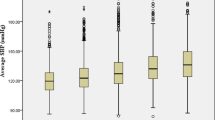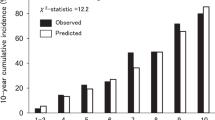Abstract
The aims of our study were: (i) to estimate the yearly incidence rates based on one vs two visits in a working population and (ii) to identify incident hypertension modifiable risk factors. A total of 21 566 normotensive subjects were included in a 1-year cohort study. Blood pressure (BP) levels at inclusion and at the second year screening were measured on the basis of two visits, that is, if BP was over 140/90 mmHg in untreated subjects, they were invited to a control visit 1 month later. Height and weight were measured and behavioural risk factors were collected. Among the 17 465 subjects who completed the entire protocol (9691 men and 7774 women), 17 026 remained normotensive at a 1-year interval and 439 (325 men and 114 women) became hypertensive. Crude yearly incidence rates based on one visit were 6.21% in men and 3.06% in women, compared with 3.04% in men and 1.34% in women when incidence rates were based on two visits, a more than twofold difference. Age and body mass index at baseline were the two major independent determinants of incident hypertension in both genders. Smoking and alcohol consumption were significant risk factors in men but not in women, and a low educational level only in women. BP measurement on separate occasions is necessary to avoid overestimation of incidence. Weight in both genders and alcohol consumption in men were the main modifiable predictors of hypertension.
This is a preview of subscription content, access via your institution
Access options
Subscribe to this journal
Receive 12 digital issues and online access to articles
$119.00 per year
only $9.92 per issue
Buy this article
- Purchase on SpringerLink
- Instant access to full article PDF
Prices may be subject to local taxes which are calculated during checkout

Similar content being viewed by others
References
Mac Mahon S et al. Blood pressure, stroke, and coronary disease. Part I, prolonged differences in blood pressure: prospective observational studies corrected for the regression dilution bias. Lancet 1990; 335: 765–774.
Lewington S et al. Prospective Studies Collaboration. Age-specific relevance of usual blood pressure to vascular morbidity: a meta-analysis of individual data for one million adults in 61 prospective studies. Lancet 2002; 360: 1903–1913.
Whelton PK . Epidemiology of hypertension. Lancet 1994; 344: 101–106.
Kannel WB . Blood pressure as a cardiovascular risk factor: prevention and treatment. JAMA 1996; 275: 1571–1576.
Burt VL et al. Trends in the prevalence, awareness, treatment, and control of hypertension in the adult US population: data from the Health Examination Surveys, 1960 to 1991. Hypertension 1995; 26: 60–69.
Hajjar I, Kotchen TA . Trends in prevalence, awareness, treatment, and control of hypertension in the United States, 1988-2000. JAMA 2003; 290: 199–206.
Wolf-Maier K et al. Hypertension prevalence and blood pressure levels in 6 European countries, Canada, and the United States. JAMA 2003; 289: 2363–2369.
Chamontin B et al. Prevalence, treatment, and control of hypertension in the French population: data from a survey on high blood pressure in general practice, 1994. Am J Hypertens 1998; 11: 759–762.
Primatesta P, Brookes M, Poulter NR . Improved hypertension management and control. Results from the Health Survey from England 1998. Hypertension 2001; 38: 827–832.
Lang T et al. Prevalence and therapeutic control of hypertension in 30 000 subjects in the workplace. Hypertension 2001; 38: 449–454.
De Gaudemaris R et al. Socioeconomic inequalities in hypertension prevalence and care. Results of an epidemiologic study on 30 000 subjects at the workplace in France. Hypertension 2002; 39: 1119–1125.
Chobanian AV et al. The seventh report of the Joint Committee on the Prevention, Detection, Evaluation, and Treatment of High Blood Pressure. JAMA 2003; 289: 2560–2572.
Vargas CM, Ingram DD, Gillum RF . Incidence of hypertension and educational attainment: the NHANES I Epidemiologic Follow-up Study. Am J Epidemiol 2000; 152: 272–278.
André JL, Monneau JP, Gueguen R, Deschamps JP . Five-year incidence of hypertension and its concomitants in a population of 11 355 adults unselected as to disease. Eur Heart J 1982; 3 (Suppl C): 53–58.
Vasan RS et al. Assessment of frequency of progression to hypertension in non-hypertensive participants in the Framingham Heart Study: a cohort study. Lancet 2001; 358: 1682–1686.
O'Brien E, Mee F, Atkin N, Thomas M . Evaluation of three devices for self-measurement of blood pressure according to the revised British Hypertension Society Protocol: the Omron HEM 705-CP, Philips 5332, and Nissei DS-175. Blood Press Monit 1996; 1: 55–61.
SAS/STAT User's Guide. Version 8.2. SAS Institute Inc: Cary, NC, 1999–2001.
Rothman KJ, Greenland S . Modern Epidemiolgy. Lippincott Raven: Philadelphia, 1998, pp 29–46.
Birkett NJ . The effect of alternative criteria for hypertension on estimates of prevalence and control. J Hypertens 1997; 15: 237–244.
Bovet P et al. Assessing the prevalence of hypertension in populations: are we doing it right? J Hypertens 2003; 21: 509–517.
Markovic N et al. Adequacy of a single visit for classification of hypertensive status in a Nigerian civil servant population. Int J Epidemiol 1994; 23: 723–729.
Rywik SL et al. Incidence and correlates of hypertension in the Atherosclerosis Risk in Communities (ARIC) study and the Monitoring Trends and Determinants of Cardiovascular Disease (POL-MONICA) project. J Hypertens 2000; 18: 999–1006.
Dannenberg AL, Garrison R, Kannel WB . Incidence of hypertension in the Framingham Study. J Public Health 1988; 78: 676–679.
Shetterly SM, Rewers M, Hamman RF, Marshall JA . Patterns and predictors of hypertension incidence among Hispanics and non-Hispanics Whites: the San Luis Valley Diabetes Study. J Hypertens 1994; 12: 1095–1102.
Garrison RJ, Kannel WB, Stokes J, Castelli WP . Incidence and precursors of hypertension in young adults: the Framingham Offspring Study. Prev Med 1987; 16: 235–251.
Cornoni-Huntley J, LaCroix AZ, Havlik RJ . Race and sex differentials in the impact of hypertension in the United States. The National Health and Nutrition Examination Survey I Epidemiologic Follow-up Study. Arch Intern Med 1989; 149: 780–788.
Ford ES, Cooper RS . Risk factors for hypertension in a national cohort study. Hypertension 1991; 18: 598–606.
Ford ES et al. Physical activity behaviors in lower and higher socioeconomic status populations. Am J Epidemiol 1991; 133: 1246–1256.
Friedman GD et al. Precursors of essential hypertension: body weight, alcohol and salt use, and parental history of hypertension. Prev Med 1988; 17: 387–402.
Tsuruta M et al. Association between alcohol intake and development of hypertension in Japanese normotensive men: 12-year follow-up study. Am J Hypertens 2000; 13: 482–487.
Ishikawa-Takata K et al. Obesity, weight change and risks for hypertension, diabetes and hypercholesterolemia in Japanese men. Eur J Clin Nutr 2002; 56: 601–607.
Fuchs FD et al. Alcohol consumption and the incidence of hypertension: the Atherosclerosis Risk in Communities Study. Hypertension 2001; 37: 1242–1250.
Whelton PK et al. Primary prevention of hypertension. Clinical and public health advisory from the National High Blood Pressure Education Program. JAMA 2002; 288: 1882–1888.
Acknowledgements
This study was undertaken under the auspices of the French Society of Hypertension and its epidemiology group. The following pharmaceutical companies have supported the activity of the group and this study: Astra, Bristol-Myers-Squibb, Debat Cardio, Hoeschst-Houde, Information Servier, Lipha, Merck Sharp & Dohme Chibret, Roussel, Rhône Poulenc Rorer, Wyeth-Lederle, Zeneca, and Glaxo Welcome. We thank the staff of the work sites without whom this work would not have been possible.
Samia Radi was supported by a combined grant of the French Society of Hypertension and Sanofi-Synthélabo.
Author information
Authors and Affiliations
Consortia
Corresponding author
Rights and permissions
About this article
Cite this article
Radi, S., Lang, T., Lauwers-Cancès, V. et al. One-year hypertension incidence and its predictors in a working population: the IHPAF study. J Hum Hypertens 18, 487–494 (2004). https://doi.org/10.1038/sj.jhh.1001682
Received:
Accepted:
Published:
Issue Date:
DOI: https://doi.org/10.1038/sj.jhh.1001682
Keywords
This article is cited by
-
Body mass index, abdominal fatness, and hypertension incidence: a dose-response meta-analysis of prospective studies
Journal of Human Hypertension (2018)
-
Protective Health Factors and Incident Hypertension in Men
American Journal of Hypertension (2010)
-
The incidence of co-morbidities related to obesity and overweight: A systematic review and meta-analysis
BMC Public Health (2009)
-
Smoking and the Risk of Incident Hypertension in Middle-aged and Older Men
American Journal of Hypertension (2008)
-
High incidence of hypertension in middle-aged French adults in the late 1990s
Journal of Human Hypertension (2008)



